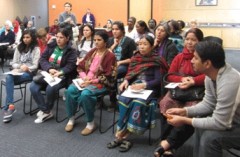LatinaLista — Tomorrow is International Women’s Day and the United States is probably the most fitting country to celebrate such a global observance. The United States, more than any other country, traces the country’s growth on the contributions of immigrants. Where in the past immigrants were predominantly male, the tide has shifted and now more women are leading the march towards calling the United States home.

However, because of current politics, there are many misperceptions about female immigrants. The Center for American Progress has released 10 Facts You Need to Know About Immigrant Women to clear up those misperceptions and set the record straight on who these women are, what they do for the country and how they are being treated by a country that doesn’t appreciate their presence enough.
1. The face of today’s immigration is more female than male. In 2010, 55 percent of all people obtaining a green card were women.
2. This trend is decades in the making. By the 1970s the number of female immigrants caught up and surpassed their male counterparts. In 2010 there were 96 immigrant men arriving for every 100 immigrant women.
3. Immigrants live in families at a greater rate than native-born Americans. Among undocumented immigrants living in the United States today, 45 percent live in families comprised of couples and children.
4. Immigrant women embrace citizenship and encourage integration. According to 2009 public opinion research by New America Media, immigrant women from a broad range of countries are overwhelmingly the drivers of naturalization in their families, with 58 percent of respondents stating that they felt the strongest in their family about becoming an American citizen.
5. Immigrant women (like most) make enormous sacrifices for their families. New America Media found that only 13 percent of immigrant women work as professionals in the United States, even though 32 percent of them worked as such in their home country.
6. Immigrant female business owners outpace their American-born counterparts. In 2010, immigrant women comprised 40 percent of all immigrant business owners and 20 percent of women business owners in general.
7. Immigration enforcement is taking its toll on immigrant families. Rising deportations of undocumented immigrants are separating children from their parents. A 2011 report from the Applied Research Center found that more than 5,000 children living in foster care had parents who had been detained or deported from the United States.
8. Immigrant women workers are vulnerable to abuse at work. Immigrant women make up close to the entire population of domestic workers in major cities such as New York.
9. They are also vulnerable to abuse at home. Domestic abuse affects immigrant and American-born women alike, but immigrant women suffer from particular vulnerabilities, particularly from abusive partners who use the woman’s immigration status to keep them from leaving an abusive marriage or relationship.
10. Human trafficking is another form of abuse endured by immigrant women and children. The U.S. Department of Justice estimates that each year 50,000 people are trafficked into our nation. U.S. officials can grant up to 5,000 so-called “T” Visas to help free immigrant women forced into, among other things, the sex trade, but studies find that barely any are being granted.




